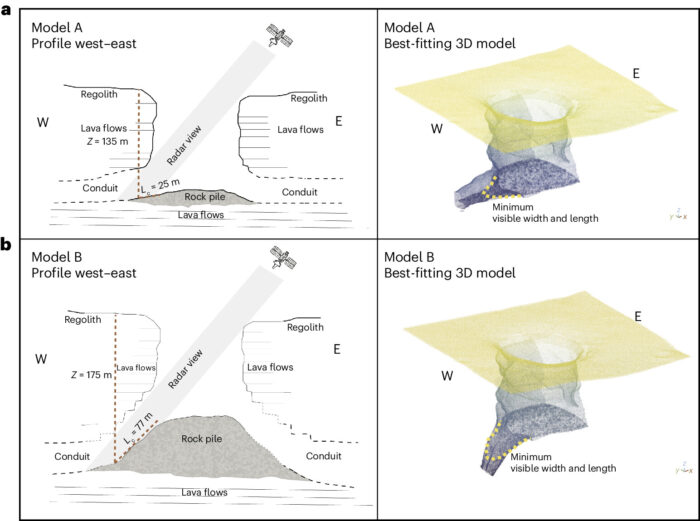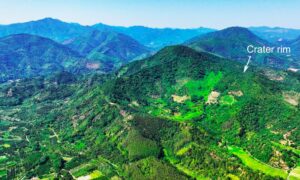Location, location, location. Countries and space agencies worldwide are looking for prime real estate on the Moon as the race to colonize our planet’s solitary large orbiting body continues.
Now, an Italian-led team publishing in the journal Nature Astronomy thinks it found a contender for a future colony site — a 100m wide, 170m deep cave not far from where humans first set foot on the barren landscape.
The finding represents the first confirmed cave on the Moon, though scientists have long speculated that caves such as this exist.
“It’s really exciting. When you make these discoveries, and you look at these images, you realize you’re the first person in the history of humanity to see it,” Leonardo Carrer, a scientist at the University of Trento in Italy and one of the paper’s lead authors, told the BBC.

A figure from the paper in Nature Astronomy illustrates how scientists used 14-year-old-radar data to verify the first moon cave. Figure: Leonardo Carrer et al., Nature Astronomy
To make the discovery, Carrer and his team used radar data from a 14-year-old unmanned lunar mission.
In 2010, the Lunar Reconnaissance Orbiter craft passed over a broad, relatively flat plain known as the Sea of Tranquility. Fans of lunar history will remember the feature as the landing site of the Apollo 11 mission — when American astronauts Neil Armstrong and Buzz Aldrin became the first humans to set foot on the Moon.
Some 400km from where the Eagle famously landed, a collapsed lava tube created a wide depression. For years, no one was sure if the pit was a legitimate cave, or just a shallow hole. Nobody, that is, until the Italian team dug into the radar data from the 2010 Lunar Reconnaissance Mission and compared it with similar data from lava tubes on Earth.
A (possibly) ideal location
In their paper, the scientists note that the cave — and, potentially, others like it in the Sea of Tranquility — could be an ideal location for future colonies. Caves would partially shield people and equipment from radiation, temperature fluctuations, and other hardships of life on the moon.
“After all, life on Earth began in caves, so it makes sense that humans could live inside them on the Moon,” Carrier said.
But the actual work of colonizing caves wouldn’t necessarily be any easier than setting up a habitation anywhere else on the Moon, the scientists point out. And living in a Moon cave would come with its own challenges. For instance, you’d need some way to get in and out of the thing.
Helen Sharman, the first British astronaut to make it to space, told the BBC that future colonists would need “jet packs or a lift” if they called the cave home.
Leaving aside the practicalities, the location might benefit future scientists. The cave’s shielded properties would allow geologists to study rocks that haven’t weathered from millennia of exposure to the harsh surface.






